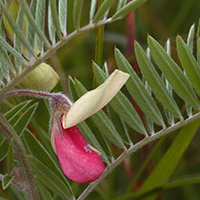Virginia goat’s-rue
Scientific name: Tephrosia virginiana

Cover photo credit: Allen Woodliffe
Status
Endangered
‚ÄúEndangered‚Äù means the species lives in the wild in ∞ƒ√≈”¿¿˚ but is facing imminent extinction or extirpation.
Date added to the Species at Risk in ∞ƒ√≈”¿¿˚ List
The Virginia goat’s-rue was already assessed as endangered when the Endangered Species Act took effect in 2008.
Read the Assessment Report
What it looks like
Virginia goat‚Äôs-rue is a member of the pea family. In ∞ƒ√≈”¿¿˚, it usually grows no more than half a metre in height. The stem, branches, and leaf stalks are covered in silky white hairs.
The leaves are alternate (each leaf arising from a different point along the stem) and segmented into nine to 31 small leaflets.
Each leaflet is one to three centimetres long with a smooth upper surface and densely hairy underside. This plant produces showy pea-like flowers with upper petals pale yellow or white, and lower ones pink.
Fruit are linear pods 3.5 to 5.5 centimetres, flattened to slightly curved with six to 11 kidney shaped seeds.
Where it lives
Virginia goat’s-rue grows in open, sunny areas with sandy soil, such as prairies, open oak and pine forests on sandy ridges, and sand dunes. It has also been found in more disturbed habitats, such as roadsides and abandoned fields.
In ∞ƒ√≈”¿¿˚, Virginia goat‚Äôs-rue is limited to acidic sand deposits in remnant Black oak savanna and open Black oak woodland.
Where it‚Äôs been found in ∞ƒ√≈”¿¿˚
Virginia goat‚Äôs-rue range extends from New Hampshire west to Nebraska and Texas, and south to Florida. Populations at the northern limits of the range, in southern ∞ƒ√≈”¿¿˚, New Hampshire, New York, Michigan and Wisconsin, are widely separated.
In Canada, the Virginia goat‚Äôs-rue is found only in southwestern ∞ƒ√≈”¿¿˚ where it is believed to be restricted to two sites on the Norfolk Sand Plain near Turkey Point on Lake Erie‚Äôs north shore. It is thought to be extirpated from at least four other sites in this area.
Two invasive plant species, periwinkle (Vinca minor) and Oriental bittersweet (Celastrus orbiculata), are known to occur with Virginia goat’s-rue at one location.
What threatens it
Threats to Virginia goat’s-rue include habitat destruction due to erosion and the growth of trees and shrubs in areas where open sandy habitat was previously maintained by natural fire regimes.
ATV traffic and clearing of vegetation under hydro lines may pose a threat to some plants. Sand extraction is a known threat at one site.
One known population is located near a roadside and could be harmed by sand removal, herbicide spraying, and road widening.
Action we are taking
Endangered Species and their general habitat are automatically protected.
Recovery strategy
A recovery strategy advises the ministry on ways to ensure healthy numbers of the species return to ∞ƒ√≈”¿¿˚.
Read the executive summary (November 22, 2013)
Read the recovery strategy (November 22, 2013)
Government response statement
A government response statement outlines the actions the government intends to take or support to help recover the species.
Read the government response statement (December 15, 2014)
Review of progress
A review of progress made toward protecting and recovering a species is required no later than the time specified in the species’ government response statement, or not later than five years after the government response statement is published if no time is specified.
Read the report on progress towards the protection and recovery of 16 species at risk, including Virginia goat’s-rue (Tephrosia virginiana) (2019).
Habitat protection
General Habitat Protection - June 30, 2008
What you can do
Report a sighting
Report a sighting of an endangered animal or plant to the Natural Heritage Information Centre. Photographs with specific locations or mapping coordinates are always helpful.
Volunteer
Volunteer with your local nature club or provincial park to participate in surveys or stewardship work focused on species at risk.
Be a good steward
- Private land owners have a very important role to play in species recovery; if you find Virginia goat’s-rue on your land, you may be eligible for stewardship programs that support the protection and recovery of species at risk and their habitats
- Invasive species seriously threaten many of ∞ƒ√≈”¿¿˚‚Äôs species at risk; to learn what you can do to help reduce the threat of invasive species, visit:
- Virginia goat‚Äôs-rue and many other species at risk depend on healthy grassland prairies, a rare habitat in ∞ƒ√≈”¿¿˚. .
Report illegal activity
Report any illegal activity related to plants and wildlife to
Quick facts
- Aboriginal people used Virginia goat’s-rue to treat tuberculosis, fever, coughing, reproductive problems, and even hair loss.
- Virginia goat’s-rue has its own self-defence against pesky insects; the chemical rotenone has been found in the plant, a chemical that is used as an insecticide and piscicide.
- The plant is also called rabbit pea because of the white hairs covering its stem, branches, and leaf stalks.
- Virginia goat’s-rue can be mistaken for the common and weedy crown vetch, also in the pea family; crown vetch has pink and white bicoloured flowers and similar compound leaves; however, it is a sprawling plant that cannot grow very tall without draping over other plants, whereas goat’s-rue has tall upright stems and larger flowers.
- Fire plays a very important role in maintaining prairie habitat where Virginia goat’s-rue lives; fire stimulates the growth of hardy prairie flowers while naturally removing trees and shrubs that would otherwise overtake this unique habitat.